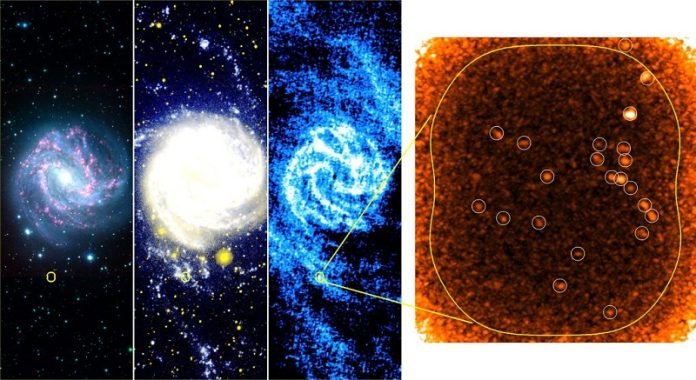
In the vast expanse of the universe, stars form in a variety of surprising places, including the far edges of galaxies.
Understanding how and why stars form in these remote regions has puzzled astronomers for years. But now, a groundbreaking discovery sheds light on this cosmic mystery.
A team of astronomers, led by Professor Jin Koda from the Department of Physics and Astronomy, embarked on a journey to explore star formation in the outer regions of galaxies.
Using the powerful Atacama Large Millimeter/submillimeter Array (ALMA), they focused on the spiral galaxy M83, located 15 million light-years away from Earth. What they found was nothing short of astonishing.
In the remote edges of M83, the team discovered 23 molecular clouds.
These clouds are the birthplaces of stars and are commonly found in the inner parts of galaxies. However, finding them at the edges of a galaxy was unexpected.
Molecular clouds are typically large, but the ones found in M83 were different: only their dense, star-forming cores were visible, not the entire cloud.
This discovery is significant because it challenges our understanding of where and how stars form in the universe.
It was already known that young stars exist at the edges of galaxies, but until now, the exact locations where they form were elusive. The discovery of these molecular clouds provides a crucial piece of the puzzle.
The research, which will be presented at the 243rd meeting of the American Astronomical Society, confirms earlier hypotheses and brings new insights from additional observations with the Jansky Very Large Array (VLA) and Green Bank Telescope (GBT).
Professor Koda explains, “The star formation at galaxy edges has been a mystery since their discovery by NASA’s GALEX satellite 18 years ago. Our findings offer a clue to the processes of star formation in these extreme environments.”
The study also sheds light on the relationship between these molecular clouds and the surrounding atomic gas. Typically, atomic gas transforms into dense molecular clouds, which then form stars. However, this process is surprisingly inefficient at the edges of galaxies.
Amanda Lee, a key member of Koda’s team and a former undergraduate student, played a crucial role in processing data from the GBT and VLA, uncovering the atomic gas reservoirs at the galaxy’s edge.
Her work highlights the fact that while we now know where stars form in galaxy outskirts, the reason why the atomic gas there does not efficiently turn into star-forming molecular clouds remains a mystery.
Lee, now pursuing her Ph.D. in astronomy, reflects on the nature of astronomical research: “Pursuing answers to one mystery often leads to another. That’s what makes astronomy so exciting.”
In essence, this research not only provides answers but also opens new avenues for questions about star formation. It’s a reminder of the ever-evolving nature of our understanding of the universe, where each discovery is a step forward in unraveling the grand tapestry of the cosmos.



